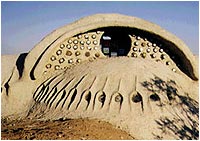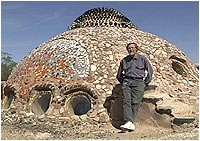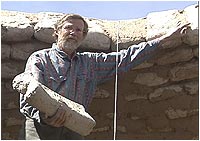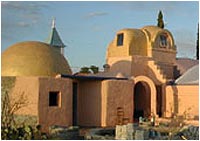 |
|
Sean Sands is a master of papercrete dome building. |
Papercrete is relatively light and quite strong, which makes it an ideal material for building arches, domes, and vaulted ceilings. In practical terms, the advantage of domes and vaulted ceilings is that they obviate the need for expensive and often insufficiently insulated roof systems. Papercrete is used for the ceilings as well as the walls. Besides providing great insulation, this minimizes the number and variety of tools necessary in construction. Over the life of a home, the roof is arguably the area which requires the most maintenance. By building dome and vaulted ceilings, a great deal of extra maintenance expense is avoided. In aesthetic terms, curved lines, rounded openings and high ceilings are simply more interesting, graceful, comforting and relaxing than sharp lines and squares. Both designs have their place.
 |
| Sean Sands beautiful earth-sheltered domes cost next to nothing. |
 |
| A knot in the rope next to
Sean determines the inward position and tilt of the block. |
Sean Sands builds his domes using fidobe, a version of papercrete with no cement. (Some practitioners have expressed the viewpoint that using unstabilized padobe or fidobe blocks for domes may be unsound.) See
Mixes for more information on various papercrete formulas. Sean's building methodology is fascinating and simple. He starts by attaching a rope to a pivoted anchor set in the ground at the center point of the proposed dome. He then stretches the rope taut, and ties a knot in the rope at the radius of the dome. With the rope pulled taut, that knot can be moved left or right, up or down, to define all possible horizontal and vertical arcs. To build the dome, the rope is pulled taut and each block is positioned so that the knot can touch the block's inner surface. As each course of block is laid, the knot and the angle of the rope determine the gradual inward position and tilt of the blocks. This procedure is followed all the way to the top of the dome. As each layer of block is completed, that course locks into place against itself. This makes it possible to build the dome without any interior support. According to Sean, it's similar to building a paper igloo, but without the need to shape the individual blocks. When the dome is complete, Sean digs out the earth beneath it to create higher ceilings. Sean's domes are a testament to what is possible with papercrete, a rope, a mixer and a few hand tools.
 |
|
Clyde T. Curry builds exotic domes and vaulted ceilings. |
Clyde T. Curry, in Texas, constructs papercrete domes (vaulted ceilings) on top of above-ground papercrete walls and arches. His papercrete blocks are classic adobe dimensions - 10" x14" x 4" made with Portland cement. Clyde has a good deal of informal architectural and engineering experience. His unusually interesting and attractive work combines plush, comfortable, luxurious interiors with exotic, mid-eastern looking exteriors. His research and designs have given papercrete a provocative look and a promising future.
For excellent and easy to understand directions for building domes and vaults on top of standard height walls, take a look at "Ceramic Houses & Earth Architecture" by Nadir Khalili. Even though the book is about earth construction, the techniques work extremely well with papercrete because it is so much lighter.
|
